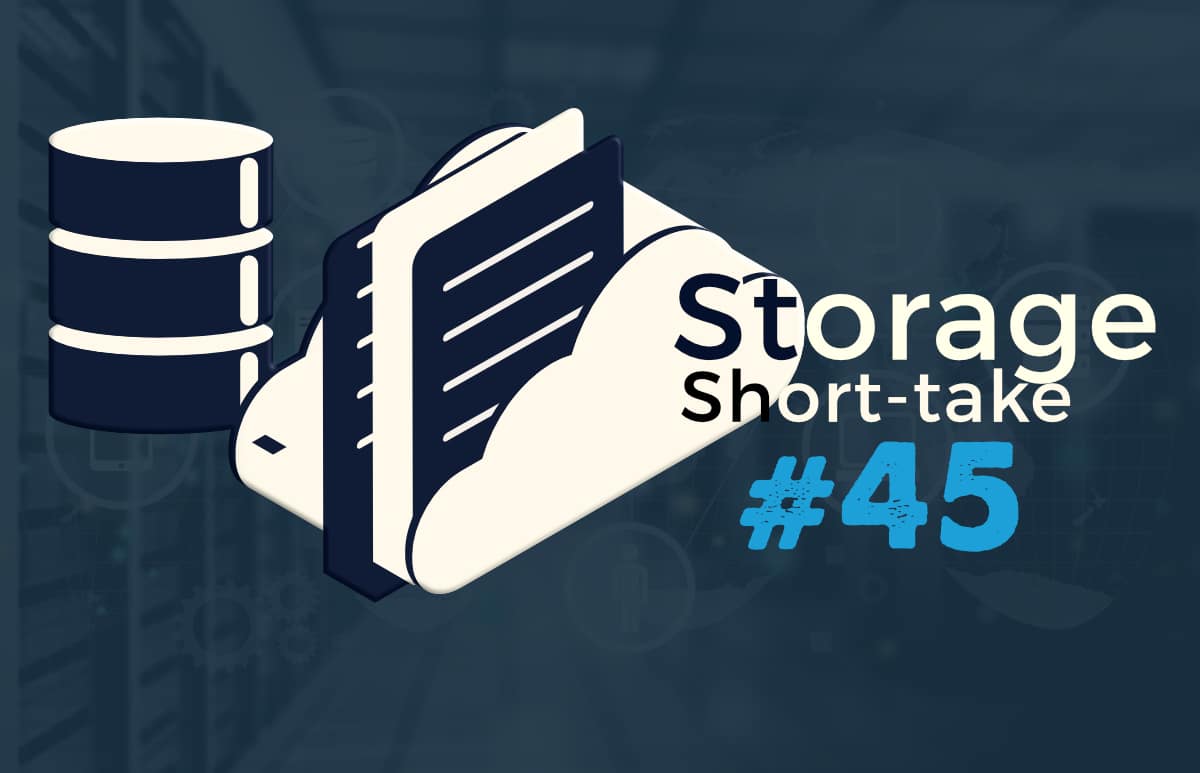
Well, I made a little mistake this week. I put a post on LinkedIn saying that I was willing to promote independent bloggers by including them in my Storage Short Take. Unfortunately, I wasn't clear enough, and people thought that I was trying to hire bloggers for this blog.
Ooops.
While I can't hire anyone (I don't get any revenue from this blog, so I can't pay anyone anything), I am willing to add links to good independent and vendor-neutral content.
This one is a wee bit longer than usual, perhaps, but as always links are valid at time of publication.

Storage Media and Technology
According to TechRadar, 16TB NVMe SSDs aren't just around the corner. In a nutshell, the real issue with M.2 for that capacity is power (both heat and dissipation). It's a solvable problem, but not an easy one to solve.
The number of Terrabytes you write to your SSD per day can affect the warranty. To be honest, I've never bothered with the warranties on drives, myself. It's just never been worth it for me. This article, though, does show a bit about how SSDs work, and it's worth a read for that info alone.
The economy is a mess, and it's going to take a while for it to settle down. One of the things that's been a big deal has been the supply chain issues and the near-impossibility of creating accurate forecasts for 2022 and 2023. This leaves an oversupply of NAND Flash at the moment, but the pendulum will likely swing violently the other way before you know it.
Curtis Preston, "Mr. Backup," has written a very good primer on the different media you can use (and why) for archiving.
Now this is interesting. Korean academic researchers have published a reference design for SSDs with both NAND and persistent memory (PM). It's a clever way to handle the different I/O characteristics that workloads like databases have that can force performance trade-offs.
In my world, there is a lot of talk about "disaggregation." It's a buzzword, sure, but when done properly it's a very promising technique. That's right, technique, not product. It has to do with putting the right tool for the job in the right place at the right time. Samsung has been experimenting with "disaggregated storage" at the SSD level (DSS with SSDs?!?) and have some interesting preliminary results. If you can get past the obvious marketing language, it's a good description of the philosophy behind it.
Chris Mellor has a little more detail on the DNA Storage work.
Now here is an interesting possible use case for computational storage. It has to do with the idea of 'Proxy re-encryption," which is a method of encrypting data in an otherwise permissionless system in a disaggregated format (such as blockchain). This is different from self-encrypting drives (SED), because it happens at a higher layer.
Chin-Fah Heoh has a great article on ransom-ware, and how it really is a data management problem. What he's saying (echoing Enrico Signoretti's take) is that this is a process issue, not a point-in-time issue.
"AI" has become a big buzzword lately. How do you know it's a buzzword? Because when you can mix-and-match $NEWTECH with "AI," it has lost all meaning. Try it yourself with this article. Replace "Telemetry" for "AI" and see if you don't get exactly the same meaning.
Tom Coughlin, a frequent contributor to Forbes (see his coverage of the Persistent Memory + Computational Storage Summit below) has written a report (pdf) on how NVMe is affecting the Media and Entertainment Industry.
This came up in my LinkedIn feed (one of the few non-Press Releases that the site seems to be filled with. It's an older article but still valid. It's an Overview on Database Corruption and it's a very good primer on the subject.
Storage Companies in the News
Blocks & Files has a vendor-centric article showcasing MemVerge memory pooling with CXL. They're joining up with Liqid to create a new memory tier that's accessible by CXL-connected processors. The article makes comparisons to SANs and Fibre Channel, and I think I understand the metaphor (creating a full network of peer relationships for memory the way that FC did for storage capacity), but it's still a bit of a stretch when taken to it's logical conclusion.
Synology has updated its list of security vulnerabilities.
Qumulo, a cloud storage and backup company, had a major RIF. Once considered a "unicorn" (valuation of over $1B), the economic realities have hit hard. (See below on the new section on Employment Opportunities).
Nasuni, a cloud file data services provider, has just picked up Storage Made Easy.
StorageNewsletter has an article on 20 storage M&A events at Mid-2022. It's a pretty good cheat-sheet to see some of the changes in the industry at a glance (note: StorageNewsletter puts their articles behind a paywall rapidly, so you may want to look sooner rather than later).
Enterprise Storage Forum has a breakdown of who they think the Top Storage Virtualization Providers are. It's not clear how these are ranked (by market share, approach to technology, personal favorites, pay-for-play), but it does provide a decent short summary of the selected offerings.
Cloud has certainly changed a lot. Take a look at the number of storage vendors speaking at Cloud Field Day 14: WekaIO (a parallel file system company), Zerto (Backup and Recovery), LightBits Labs (NVMe-oF storage), NetApp (well, it's NetApp), and Komprise (Automated Data Tiering),
Industry Associations and Standards
SNIA announced that the DNA Data Storage Alliance has joined as a Technology Affiliate. It's a very interesting concept: storing data inside of DNA has the potential to last reliably for thousands of years.
PCI-SIG has announced the 7.0 Specification for the ubiquitous transport protocol. This doubles the data rate to 128 GT/s. But before you get all excited, it's useful to know that v6 is a radical departure and could require some major hardware forklift upgrades.
Once again, government regulation threatens to take Good Intentions and turn it into Really Bad Law™. Let's face it. Any time Elizabeth Warren tries to do anything involving technology the knee-jerk reaction should be to fight it at all costs. This is no exception.
For those who can't be bothered to pay attention to anything longer than a TikTok video, NVM Express has put together an infographic of the new features for NVMe 2.0.
Webinars, Blogs, and Conferences
Registration is now open for the SNIA Storage Developer Conference, September 12-15 in Fremont, CA.
Seems like a lot of people are excited to rejoin the Flash Memory Summit in August Face-to-Face. I'm afraid I have other obligations so won't be in attendance this time, but it does seem like it's going to be a good show.
Tom Coughlin's second Forbes piece on the SNIA Persistent Memory and Computational Storage Summit is out. He has a couple typos (Gary Grider's name is misspelled, but that might have been an autocorrect error), but the summary of the Accelerated Bunch of Flash is an excellent one.
Here's a good short video on how Fibre Channel Zoning works, done by T11 Contributor (and FCIA Board Member) Craig Carlson.
How much do you really know about really deleting your data? The common term nowadays is called "sanitization" and it's a lot more complicated than people think.
Check out this short interview with Richelle Ahlvers, my colleague from SNIA, about what's new in Swordfish.
If you haven't taken a look at Gret Schultz StorageIO blogs, you've been missing out. If you want to be better at being involved in storage, you really want to listen to his advice on good tradecraft.
Employment Opportunities
I don't know how long I'll be adding this section to the Short Takes, but I've been seeing some job-related notices come through and I thought that perhaps someone may find them useful. Note, recruiters - please don't bother.
If anyone happens to get connected by this, I do like good Single Malt Scotch. Just sayin'.
[Note: These are not endorsements, just a public service announcement of storage-related positions and people. Hopefully they'll be able to find each other.]Open Positions Available
Samsung is hiring a Staff Firmware Engineer, SSD Performance Lead.
Storage People Available
David Chapa is an excellent technical evangelist and marketing person with many years of being in the storage industry. One of the best "geek-to-English" people in the industry.
Bonus Round
This made me laugh.
Hard disk drive toilet paper. pic.twitter.com/bURamJw2S4
— Chris M Evans (@chrismevans) June 22, 2022
